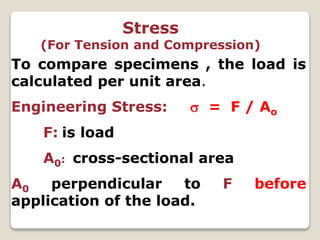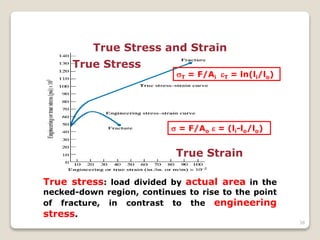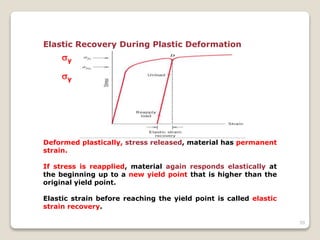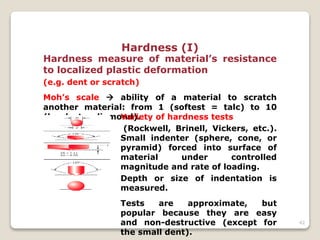Engg mat
- 2. Cont… Engineers are primarily concerned with the development and design of machines, structures etc. These products are often subjected to forces/ deformations, resulting in stresses/strains, the properties of materials under the action of forces and deformations becomes an important engineering consideration. The properties of materials when subjected to stresses and strains are called “mechanical properties”. In other words the properties that determine the behavior of engineering materials under applied forces are called “mechanical properties”.
- 3. How materials deform as a function of applied load Testing methods and language for mechanical properties of materials. Introduction Stress, (MPa) Strain, (mm / m
- 4. CONCEPTS OF STRESS AND STRAIN If a load is static or changes relatively slowly with time and is applied uniformly over a cross section or surface of a member, the mechanical behavior may be ascertained by a simple stress–strain test; these are most commonly conducted for metals at room temperature. There are three principal ways in which a load may be applied: namely, tension, compression, and shear
- 5. Types of Loading Tensil e Compressive Shea r Torsion
- 6. Stress (For Tension and Compression) To compare specimens , the load is calculated per unit area. Engineering Stress: = F / Ao F: is load A0: cross-sectional area A0 perpendicular to F before application of the load.
- 7. Strain (For Tension and Compression) Engineering Strain: = l / lo ( 100 %) l: change in length lo: original length. li instantaneous length. Stress / strain = /
- 8. Shear and Torsion Shear stress: = F / Ao F is applied parallel to upper and lower faces each having area A0. Shear strain: = tan ( 100 %) is strain angle She ar Torsio n
- 9. Torsion is a variation of pure shear, wherein a structural member is twisted. Torsional forces produce a rotational motion about the longitudinal axis of one end of the member relative to the other end. Examples of torsion are found for machine axles and drive shafts, and also for twist drills. Torsional tests are normally performed on cylindrical solid shafts or tubes. A shear stress is a function of the applied torque T, whereas shear strain is related to the angle of twist,
- 10. Contd. The response of a material to applied forces depends on the type and nature of the bond and the structural arrangement of atoms, molecules or ions. Basic deformation types for load carrying materials are: 1. Elastic deformation (deformations are instantaneously recoverable) 2. Plastic deformation (non-recoverable) 3. Viscous deformation (time dependent deformation)
- 11. Viscous Deformation • Plastic deformations in noncrystalline solids (as well as liquids) occurs by a viscous flow mechanism. Usually attributed to fluids. But solids may also behave like viscous materials under high temperature and pressure. • Viscous materials deform steadily under stress. • Deformations are time dependent.
- 12. Based on the above mentioned deformation characteristics, several material idealizations could be made. Such as: 1. Elastic Materials 2. Plastic Materials 3. Elastoplastic Materials 4. Viscoelastic Materials specimenextensometer
- 13. 1. Elastic Materials Return to the their original shape when the applied load is removed. Unloading d P Loading
- 14. 2. Plastic Materials No deformation is observed up to a certain limit. Once the load passes this limit, permanent deformartions are observed. δ P Limit Plastic deformation Unloading Loading
- 15. 3. Elastoplastic Materials • Up to a limit shows elastic properties. Within this limit if the load is removed, returns to its original shape. • If the load passes the limit, plastic deformations are observed. Plastic deformation Elastic deformation P δ Elastic Limit
- 16. 4. Viscoelastic Material Deformations are time-dependent. P δ Slow Loading-Unloading Fast Loading-Unloading
- 18. • The physical properties of some substances depend on the crystallographic direction in which the measurements are taken. • For example, the elastic modulus, the electrical conductivity, and index of refraction may have different values in the [100] and [111] directions. • This directionality of properties is termed as anisotropy, and it is associated with the variance of atomic or ionic spacing with crystallographic direction. • Substances in which the measured
- 20. Isotropic materials have the same mechanical properties in all directions. Anisotropic materials show different behavior in different directions. Isotropic Materials (METALS) Ξ δ1 δ2 Anisotropic Materials (WOOD) δ1 ≠ δ2 δ1= δ2 δ1≠ δ2
- 21. Hooke's Law • Modulus of Elasticity, E: • Hooke's Law: For elastic materials, stress is linearly proportional to strain and is independent of time. = E Linear- elastic E F F simple tension test
- 22. Poisson’s ratio Tension shrink laterally Compression bulge. Ratio of lateral to axial strain called Poisson's ratio . Unloaded Loaded
- 23. Poisson’s ratio z y z x is dimensionless. Sign: • lateral strain opposite to longitudinal strain Theoretical value: • For isotropic material: 0.25 • Maximum value: 0.50, • Typical value: 0.24 - 0.30
- 24. Elastic Modulus, Poisson’s Ratio and Shear Modulus For isotropic material: E = 2G(1+) G ~ 0.4E Single crystals are usually elastically anisotropic Elastic behavior varies with crystallographic direction.
- 25. Plastic deformation (Tension) Plastic deformation: • stress not proportional to strain • deformation is not reversible • deformation occurs by breaking and re- arrangement of atomic bonds (crystalline materials by motion of defects)
- 26. Tensile properties: YieldingStress Strain Yield strength: y , Permanent strain= 0.002 Yield point: P Where strain deviates from being proportional to stress (the proportional limit) A measure of resistance to plastic deformation P y 0.002
- 27. Tensile properties: Yielding For a low-carbon steel, the stress vs. strain curve includes both an upper and lower yield point. The yield strength is defined in this case as
- 28. 28 Tensile properties: Ductility percent elongation or percent reduction in area Ductility Deformation at Fracture 100 l ll EL% 0 0f 100 A AA RA% 0 f0
- 29. 29 Mechanical Properties of Metals Yield strength and tensile strength vary with thermal and mechanical treatment, impurity levels, etc. Variability related to behavior of dislocations (Elastic moduli are relatively insensitive) Yield and tensile strengths and modulus of elasticity: Decrease with increasing
- 30. 30 Toughness Toughness: ability to absorb energy up to fracture (Area under the strain-stress curve up to fracture) Units: the energy per unit volume, e.g. J/m3
- 31. Anelasticity Up to this point, it has been assumed that elastic deformation is time independent— that is, that an applied stress produces an instantaneous elastic strain that remains constant over the period of time the stress is maintained. It has also been assumed that upon release of the load the strain is totally recovered—that is, that the strain immediately returns to zero.
- 32. Example Problem
- 34. Contd..,
- 35. Resilience Resilience is the capacity of a material to absorb energy when it is deformed elastically and then, upon unloading, to have this energy recovered. The associated property is the modulus of resilience, Ur which is the strain energy per unit volume required to stress a material from an unloaded state up to the point of yielding.
- 36. Contd.., Assuming a linear elastic region
- 37. Toughness Toughness, it is a measure of the ability of a material to absorb energy up to fracture. Specimen geometry as well as the manner of load application are important in toughness determinations. For dynamic (high strain rate) loading conditions and when a notch (or point of stress concentration) is present, notch toughness is assessed by using an impact test. Furthermore, fracture toughness is a property indicative of a material’s resistance to fracture when a crack is present
- 38. 38 True Stress and Strain True stress: load divided by actual area in the necked-down region, continues to rise to the point of fracture, in contrast to the engineering stress. = F/Ao = (li-lo/lo) T = F/Ai T = ln(li/lo) True Strain True Stress
- 39. 39 Elastic Recovery During Plastic Deformation Deformed plastically, stress released, material has permanent strain. If stress is reapplied, material again responds elastically at the beginning up to a new yield point that is higher than the original yield point. Elastic strain before reaching the yield point is called elastic strain recovery. y y
- 40. Problems based on Ductility and True-Stress-At-Fracture
- 42. 42 Hardness (I) Hardness measure of material’s resistance to localized plastic deformation (e.g. dent or scratch) Moh’s scale ability of a material to scratch another material: from 1 (softest = talc) to 10 (hardest = diamond).Variety of hardness tests (Rockwell, Brinell, Vickers, etc.). Small indenter (sphere, cone, or pyramid) forced into surface of material under controlled magnitude and rate of loading. Depth or size of indentation is measured. Tests are approximate, but popular because they are easy and non-destructive (except for the small dent).
- 43. 43 Hardness (II) Tensile strength and hardness degree of resistance to plastic deformation. Hardness proportional to tensile strength Proportionality constant depends on material. Tensilestrength(MPa) Tensilestrength(103psi) Brinell hardness number
- 44. 44 What are the limits of “safe” deformation? Design stress: d = N’c : c = maximum anticipated stress, N’ the “design factor” > 1. Make sure d < y, safe or working stress: w = y/N where N is “factor of safety” > 1. For practical engineering design, the yield strength is usually the important parameter Strain Stress

















![• The physical properties of some
substances depend on the
crystallographic direction in which the
measurements are taken.
• For example, the elastic modulus, the
electrical conductivity, and index of
refraction may have different values in
the [100] and [111] directions.
• This directionality of properties is
termed as anisotropy, and it is
associated with the variance of atomic
or ionic spacing with crystallographic
direction.
• Substances in which the measured](https://image.slidesharecdn.com/enggmatchapter5-191022104015/85/Engg-mat-18-320.jpg)

























